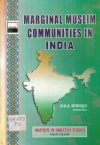Life on the margins by MOHD ZEYAUL HAQUE (April 2, 2004)
A new book on "marginal" Muslim communities of India brings these less-noticed people out of the limbo

Marginal Muslim Communities In India
M K A Siddiqui
General Editor
Rs: 220
Pages: 550 + 10
Institute of Objective Studies
New Delhi - 10025.
There are nearly 200 Muslim communities in India which, in many ways, are not yet wholly integrated into the "mainstream" Muslim society. Converted from the tribal or Hindu stock, they retain many features of their earlier life patterns, the system of belief and practices being Islamicised here and there, but retaining many of the clearly discernible features from the past, which they share with people of the same stock who are still in their original faith.
The author-editors provide valuable data on their beliefs and practices, ceremonies accompanying rights of passage like birth, marriage and death, which clearly brings out the similarities they share with the majority of Indian Muslims as well as highlights the distinctions.
The study was conducted under the leadership of MKA Siddiqui, an anthropologist of considerable standing. Siddiqui is the General Editor of this useful volume documenting the salient points of the life of groups of people described in the 1921 census as "living on the borderland between Hinduism and Islam".
A relevant question to ask here is what constitutes the marginality of these groups or, what distinguishes them from the "core" Muslim society. Some of the points that distinguish these people from the mainstream is their adherence to a "large content of pre-Islamic elements of culture", lack of their socio-cultural development, and isolation from the mainstream Muslim society.
Although most of these communities were on the margins of the larger Indian society even before they embraced Islam (largely because they happened to belong to the dispossessed and deprived castes, classes and tribes), not all of them come from economically and socially weaker sections. Notable among them are some of the Rajput groups like Thakurais of East Champaran in Bihar and some other Muslims of Rajput extraction. Their marginality is sometimes self-imposed as they want to retain their exclusivity by deciding not to marry among other Muslims and preserve their distinction.
This study is an interesting chiaroscuro of lifestyle patterns undergoing changes yet retaining the essential features. It also delineates the breathtaking diversity of Indian Muslim society, which is a convenient label under which come diverse societies bound together by certain common beliefs and practices. It is another matter that several beliefs and practices of these groups come under the "Small Tradition" rather than the "Great Tradition" of scriptural Islam.
Go Back